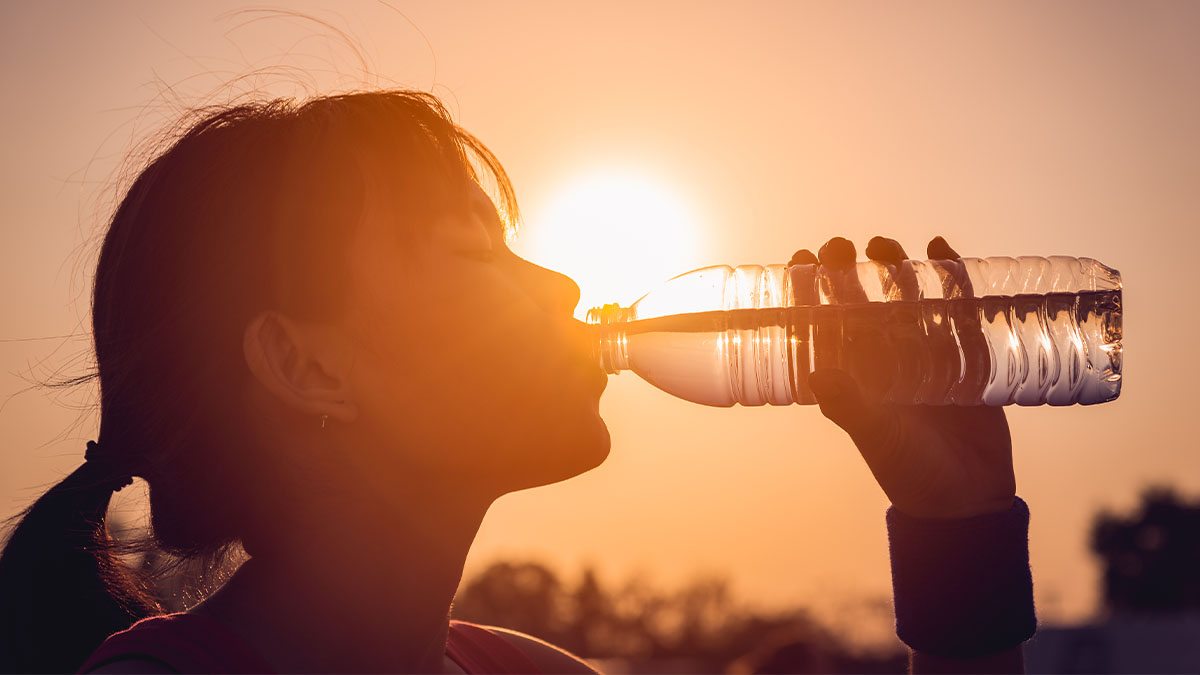How to beat the heat
It’s hot out there! Look for the signs and symptoms of heat stress and follow advice for avoiding heat-related illness from Carolina’s environment, health and safety department.

With temperatures pushing into the triple digits, now is a great time to review heat health and safety measures. Whether you are a Carolina employee working outdoors or indoors wearing personal protective equipment — or even exercising or doing yard work on the weekend — you should know the signs and symptoms of heat stress in order to prevent heat-related illnesses.
According to the University’sHeat Stress Policy, heat stress is influenced by several risk factors.
- Climate and work environment, including air temperatures and humidity.
- Demands of the work; as the body heats up it expends more energy, increasing stress on the cardiovascular system to cool the body down.
- Clothing, which can affect the body’s ability to regulate internal temperatures; it should be permeable, light, loose and well-ventilating.
- Personal characteristics, including age, weight, previous heat stress injury, underlying medical conditions and medications.
According to theenvironment, health and safety department, heat-related illnesses happen when the body is unable to regulate its internal temperature. In hot weather, the body usually cools itself down by sweating, but in some conditions — like high humidity, where air movement is limited, working in direct sun, heavy physical exertion and poor physical condition — that is not enough.
The federal government developed the OSHA-NIOSH Heat Safety Toolsmartphone app, a useful resource for planning outdoor work activities based on how hot it feels throughout the day. It features real-time heat index and hourly forecasts specific to your location, as well as occupational safety and health recommendations.
There are several illnesses that can be caused by heat stress. Signs (or what others perceive) and symptoms (what the afflicted person experiences) can be similar. It’s important to know the difference, to watch for signs and symptoms of heat stress in yourself and others and to know when to call 911.
Dehydration
When the body loses more fluids than it takes in.
Signs
- Loss of work capacity.
- Delayed response to stimuli, fatigue, weakness and dry mouth.
Symptoms
- Fatigue.
- Weakness.
- Dry mouth.
What to do
- Slowly drink water and eat foods like cucumbers, watermelon, tomatoes, strawberries, apples and grapes.
- If experiencing confusion or rapid heartbeat and breathing, go to an emergency room.
Heat exhaustion
When someone’s body loses too much water and salt through sweating.
Signs
- High pulse rate, confusion, anxiety.
- Profuse sweating.
- Low blood pressure.
- Pale face or flushing.
- Body temperature increased but below 104 degrees.
- Excessive thirst, decreased urine output.
Symptoms
- Fatigue, malaise.
- Weakness.
- Blurred vision.
- Dizziness.
- Headache.
- Nausea.
- Loss of appetite.
What to do
- Rest in a shady or air-conditioned place.
- Drink cool fluids.
- Loosen clothing.
- If you do not begin to feel better within an hour, seek prompt medical attention.
Heat stroke
When someone’s body cannot cool down at all.
Signs
- Red face.
- Mental status changes such as disorientation, confusion or irritability.
- Hot, dry skin.
- Erratic behavior.
- Collapse.
- Shivering.
- Body temperature >104 F.
- Red face.
Symptoms
- May be same as those for heat exhaustion (see above).
What to do
- Call 911 immediately.
- Cool down while waiting for medical assistance — in a cool tub of water or shower, sprayed with a garden hose, by applying ice packs or cold wet towels on head, neck, armpits and groin.
Heat rash
When the sweat glands become clogged and cannot expel sweat, which traps perspiration under the skin.
Signs
- Skin eruptions.
Symptoms
- Itching skin, prickly sensation.
What to do
- Keep the affected area cool and dry. A warm or hot shower will make it worse.
- If the rash gets worse or shows signs of infection, visit your doctor.
Heat cramps
Muscle spasms caused by heavy exercise in the heat, often caused by fluid and electrolyte loss.
Signs
- Incapacitating pain in muscle.
Symptoms
- Muscle cramps (abdominal and lower extremities).
- Fatigued muscles.
What to do
- Rest and cool down.
- Drink a sports drink with electrolytes.
- Practice gentle stretching and massaging of the affected area.
- Do not resume physical activity for at least several hours after the cramps go away.
- Call your doctor if the cramps last longer than an hour.
Heat syncope (fainting)
Not getting enough blood flow to the brain, often due to standing for long periods without movement or suddenly rising from a sitting or lying position in the heat.
Signs
- Brief fainting or near fainting behavior.
Symptoms
- Blurred vision.
What to do
- Move to a shaded or air-conditioned place.
- Sit or lie down.
- Monitor vital signs.
- Elevate legs so blood will return to the heart.
- Drink water or a sports beverage.
What to do when working and playing in the heat
- Wear wide-brimmed hats, sunscreen with at least 30 SPF and lightweight, light-colored, loose-fitting clothes.
- Use a buddy system. Check on co-workers, friends and family and ask them to reciprocate.
- Monitor your pulse and be alert to possible signs and symptoms.
- Drink small amounts of cool water regularly, regardless of your activity level. Do not wait until you are thirsty to drink water. A good rule of thumb is four cups of water every hour. It’s best to drink small amounts every 15 minutes.
- Drink sports beverages to replenish the salt and minerals lost through sweating.
- Limit outdoor work to morning hours.
- Pace yourself. Take time to acclimate to the heat. Take breaks to cool down in shady or air-conditioned areas.
- Always know where you are working or playing in case you need to call 911.




